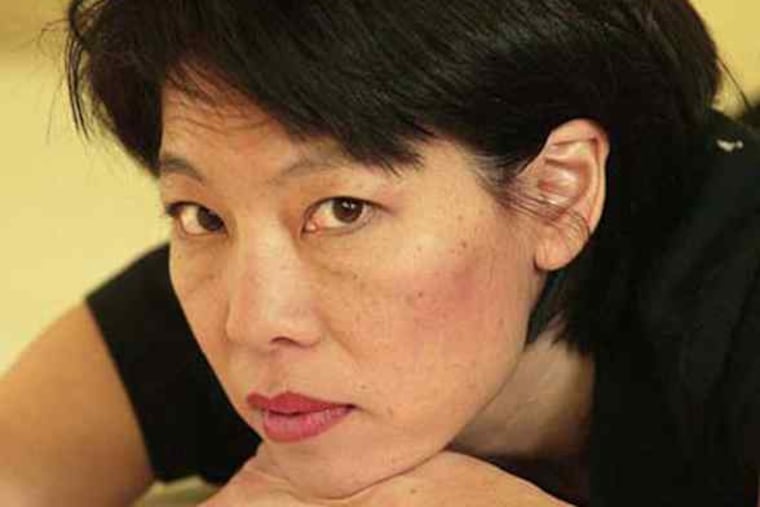An unsung hero of Tiananmen Square
Whenever I visit Tiananmen Square, with its iconic portrait of Mao, I like to try to pick out the plainclothes police among the crowds of tourists. The security cameras are, of course, easier to spot.

The Story of an Ordinary Man Who Defaced an Icon and Unmasked a Dictatorship
By Denise Chong
Counterpoint. 256 pp. $26
nolead ends nolead begins
Reviewed by Jeff Gammage
Whenever I visit Tiananmen Square, with its iconic portrait of Mao, I like to try to pick out the plainclothes police among the crowds of tourists. The security cameras are, of course, easier to spot.
The square constitutes some of the world's most sensitive real estate.
In her revealing book, author Denise Chong explains how it got that way.
Egg on Mao: The Story of an Ordinary Man Who Defaced an Icon and Unmasked a Dictatorship is the tale of Lu Decheng, a bus mechanic with a rebellious bent. He and two friends, all from Hunan province, a place where food and passions run hot, traveled to Beijing as pro-democracy demonstrators filled the square in May 1989.
Two weeks before the protest was crushed by government tanks and gunfire, the three men pelted Mao's giant portrait with paint-filled eggs. They were locked up and out of sight before the world witnessed what became known as the Tiananmen massacre.
Chong's book arrived almost 21 years later - and right on time.
Because by now we think we know the story: the growing strength of the student movement. The sense that China's communist regime, like others in Poland, Hungary, and Czechoslovakia, was about to topple. The government's murderous brutality in putting down the protest.
Estimates of those killed on June 4, 1989, range from 400 to 800 to 1,000 or more.
The following day, a man in a white shirt stepped onto Changan Avenue and blocked a line of tanks with nothing more than his body and his courage, a moment captured in photos that came to symbolize Tiananmen.
Today, all that moves on Changan - the Avenue of Eternal Peace - is traffic. Decades of censorship have left many young Chinese ignorant or unsure of exactly what transpired in spring 1989.
Even for readers familiar with the protest and its horrific end, Egg on Mao is illuminating. Chong's prose is clear and detailed, neither understated nor aggrandized. Where another writer might leap to the emotional, Chong chooses dispassion, as when Lu's wife, Qiuping, learns from the TV news of her husband's actions and arrest:
"The stunned silence and stillness in the room was like the aftermath of an explosion." Then, "Qiuping wailed so hard and long that her coworkers were convinced she was having a nervous breakdown."
It seems a small crime, throwing paint at a picture. What would the penalty be in this country? A fine and restitution. At most, a short jail sentence. In China, the men easily could have been executed.
Chong broadens the story of Tiananmen. Through Lu, she tells a tale that is equal parts tragedy, history, biography, and romance. It is most of all a story of belief, of how a man from Liuyang - a backwater best known for making fireworks - concluded that the Chinese deserved freedom of speech, press, and assembly, and did something he thought would help make it happen.
The book resonates because Chong so firmly plants the reader on the square.
Through her words, one feels the suffocating heat of mid-May and hears the wail of ambulance sirens as students faint. The brief, intense rain that fell on May 23, after the imposition of martial law, comes like cooling relief.
That was the day Lu and his friends let loose their eggs. The missiles temporarily left Mao speckled in red and purple, with a black streak on his forehead that looked like a third eyebrow.
Lu thought that he would be treated as a hero by the students, that they would see him as forcing the authorities to take down the portrait, symbolically ending Mao's control over China.
But the students thought, naively, that they could prod the government into reforming itself. In fact, almost unbelievably in retrospect, it was the students who detained Lu and turned him and his friends over to the police.
The student leaders, infected by fear and fatigue and paranoia, worried the three might be government agents, out to discredit the pro-democracy movement.
After a quick trial, Lu was sentenced to 16 years. His two friends got sentences of 20 years and life. Lu's reaction was relief: All three would live.
His prison life began a second odyssey, one that threatened his mental and physical health, and ultimately cost him love, family, and country. Yet his time in prison only hardened his belief in democracy.
Lu was released in 1998. Six years later, he made his way to Bangkok, Thailand, and in 2006 went to Canada as a refugee.
Today, Tiananmen Square is among the most visited spots in Beijing, and tours typically include a stop at Mao's portrait. After reading Chong's book, it's impossible to look at it the same way.
.